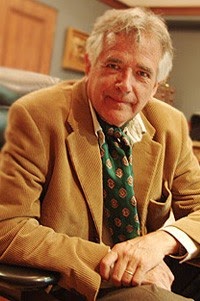Colchagua Valley occupies an area approximately 90 miles south and a little west of Santiago. The vineyards are blessed with few problems, organic or climatic. The well-drained soils are variable but predominantly sandy loam and loamy clay, some with a touch of calcium carbonate and some with a volcanic soil base, on top of granite; topsoil has depths of ½ to 3 meters and rainfall is plenty (about 700 mm per year). Colchagua shares its latitude with the wine regions of Santa Barbara, California. This is a land famous for ranchers, huasos… and Carlos Cardoen.
 |
| Carlos Cardoen (http://www.uchile.cl/) |
Carlos Cardoen basically created the wine industry in Colchagua. Not that there weren’t grapes growing and wine being made before him. But he gave the area a huge financial boost and allowed it to be transformed into a bustling tourist destination. This man is a legend here. Ask the locals and you’ll hear all sorts of stories, some of which are true and some of which are so overly embellished that one local man gave sole credit for the building of the Apache helicopter to Mr. Cardoen. But a figure like Carlos Cardoen doesn’t need much embellishment. Here is a brief summary of his story:
Carlos’ father escaped World War II by fleeing to Chile. On May 1, 1942 Carlos was born in the small farm town of Santa Cruz. His father made his living there farming plums. After attending school and obtaining a Ph.D. in engineering from the University of Utah in Salt Lake City, Cardoen returned to Chile to start a mining explosives manufacturing company. Cardoen was running his company quite successfully just prior to the reign of Pinochet, during which the US passed a law to ban exports to Chile putting the country in a rather vulnerable state sandwiched between unfriendly Peru and Argentina. This was the catalyst for Chilean Air Force commander Fernando Matthei’s request that Cardoen build a bomb, in 15 days, that was intended “to fuck up” the enemy. And thus the cluster bomb was born.
 |
| the bomb that created the Colchagua Valley wine region |
In 1990 everything changed for Cardoen with the invasion of Kuwait by Iraq. Zirconium exports to Iraq for cluster bomb manufacturing were “traced” to Cardoen (though the US government had always been aware of the exports), and suddenly he was considered to be on the enemy’s side. This whole situation eventually ended in an issuance of Cardoen’s international arrest warrant. So he stays in Chile, enjoying freedom in his country as long as he doesn’t set foot beyond the border.
 |
| Hotel Santa Cruz |
Cardoen maintains a large amount of wealth in Chile. One project he began, viewed as an attempt to obtain forgiveness for his prior actions, was the tourism industry in Santa Cruz. Those hailing from the region deny that the Colchagua Valley wine industry is his apology; they consider him a proud and valiant man who wanted to show his pride in his home town. “He could be anyone when you see him, you know,” our host at Laura Hartwig said. “The people here are happy to see him. Even though he’s 70 years old they call him Carlito and smile when he comes.” Cardoen has sponsored the town casino, numerous wineries, and the beautiful Hotel Santa Cruz with its delicious restaurant and luxurious rooms. He created the wine route almost single-handedly and is always looking for new business ideas. La Casa de los Espíritus, a distillery of sorts in Santa Cruz, is wholly funded by him… and has yet to see a profit after years of operation!
 |
| courtesy of http://www.laplayawine.com/ |
Colchagua is often termed “the next Napa.” Wines here can be structured and full of mouth-watering fruit, but some fall sadly short of expectations of the region named “2005 Wine Region of the Year” by Wine Spectator. Cabernet, Merlot, Carmenere, Cabernet Franc, Petit Verdot, Syrah, Chardonnay, Sauvignon Blanc, and the occasional Semillon make the usual appearance. Some outliers like Zinfandel can be found but are not considered to perform well here. A mild Mediterranean climate, clean air, and lots of sunlight hours allow for long ripening periods. The flavor and aroma profiles vary widely and cannot be briefly summarized perhaps due to the numerous microclimates and varying alluvial soils. And many large export-oriented producers are taking a shot at making their own distinct wines here, allowing a visitor to experience a wide array of styles all within the valley’s 75 mile stretch.
Colchagua boasts some of the most well-known exported wines coming from Chile including Viu Manent, Lapostolle, MontGras, Estampa, and Montes. I’ll be visiting a few of these wineries to see the spectrum for myself!

No comments:
Post a Comment